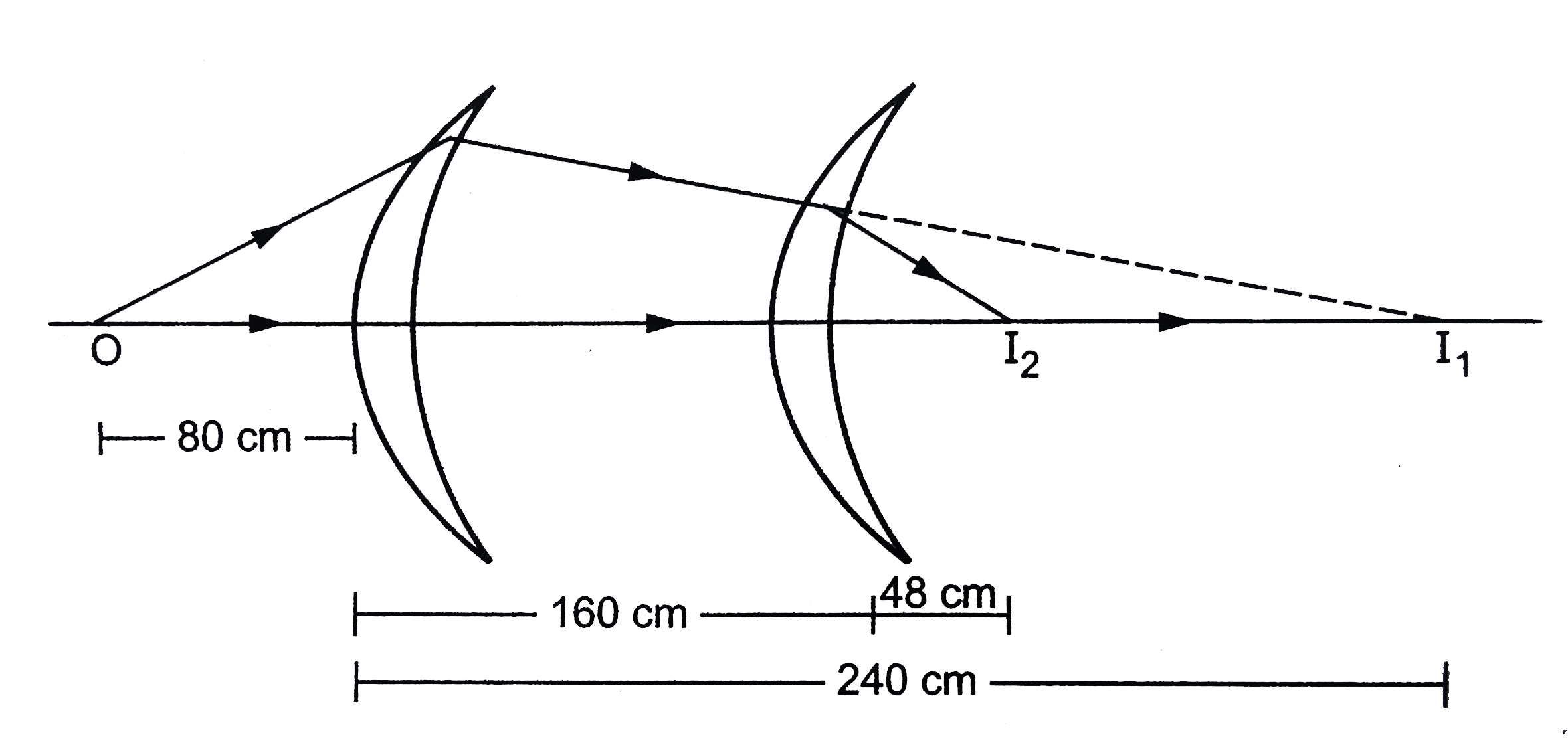A concave convex figure lens made of glas (μ=1.5) has surface of radii 20 cm and 60 cm. a. Locate the image ofan object placed 80 cm to the left of the lens along the principal axis. B. A similar lens is placed coaxially at distanc of 160 cm right of it. Locate the position of the image.

The correct Answer is:240cm;34.3cm
R1is+,R2is+
1f=(μ−1)(1R1−1R2)
1f=(1.5−1)(120−160),f=60cm
(a) Now, u=−80cm,f=60cm
As 1v−1u=1f
∴v=240cm
First image I1 is at 240cm from first lens.
(b) The second lens intercepts the converging beam. Image I1 acts as a virtual source for second lens.
u=240−160=+80cm
Use 1v−1u=1f, to get v=34.3cm.
 .
.
Topper's Solved these Questions
- RAY OPTICSBook:PRADEEPChapter:RAY OPTICSExercise:Problem For Practice(c)
Explore 27 Videos
- RAY OPTICSBook:PRADEEPChapter:RAY OPTICSExercise:Problem For Practice(d)
Explore 35 Videos
- RAY OPTICSBook:PRADEEPChapter:RAY OPTICSExercise:Long Answer (a)
Explore 5 Videos
- PROPERTIES OF BULK MATTERBook:PRADEEPChapter:PROPERTIES OF BULK MATTERExercise:Multiple choice questions
Explore 7 Videos
- SYSTEMS OF PARTICLES AND ROTATIONAL MOTIONBook:PRADEEPChapter:SYSTEMS OF PARTICLES AND ROTATIONAL MOTIONExercise:Assertion- Reason Type questions
Explore 20 Videos
Similar Questions
Knowledge Check
A diverging meniscus lens of 1.5 refractive index has concave surface of radii 3 and 4 cm the position of the image if an object is placed 12 cm in front of the lens is
A7cmB(-8cm)C9cmD10cmA diverging meniscus lens of 1.5 refractive index has concave surface of radii 3 and 4 cm the position of the image if an object is placed 12 cm in front of the lens is
A7cmB(-8cm)C9cmD10cmA diverging meniscus lens of 1.5 refractive index has concave surfaces of radii 3 and 4 cm. The position of image if an object is placed 12cm infront of the lens is
A−24cmB−8cmC8cmD24cm
The focal length of convex lens is 20 cm. If an object of height 4 cm is placed at a distance of 30 cm from the lens, find:
The position of the image
View SolutionAn object 50cm tall is placed on the principal axis of a convex lens. Its 20cm tall image is formed on the screen placed at a distance of 10cm from the lens. Calculate the focal length of the lens.
View SolutionThe source is placed 30 cm from a convex lens which has a focal length of 20cm. The source is initially located on the axis of the lens. The lens is then cut into two halves in a plane along the principal axis. The two halves are separated by a distance of 4mm. What will be the locations of the image of the source?
View SolutionA biconvex thick lens is constructed with glass (mu = 1.50). Each of the surfaces has a radius of 10 cm and the thickness at the middle is 5 cm. Locate the image of an object placed far away from the lens.
View SolutionAn object of height 1.5 cm is placed on the axis of a convex lens of focal length 25 cm . A real image is formed at a distance of 75 cm from the lens. The size of the image will be
View Solution

